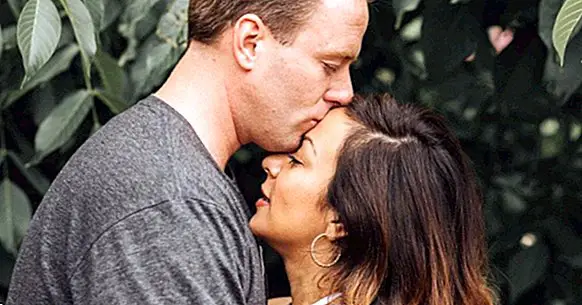The 7 types of emotional attachment (and psychological effects)
Affection, friendship, love ... are concepts linked to the fact of manifesting an emotional bond with another person, which is relevant to us and to which we feel united.
Is about a type of emotional relationship of great importance for us and that arises since childhood with our parents, relatives or primary caregivers (later this will mark our way of relating not only to them but also to the rest of people).
But not all have the same ways of relating or linking with others, depending on our experiences and perceptions about what implies type of relationship that we maintain (predictability, security, physical expression of affection ...) or factors such as temperament. That is why in reality we can talk about various types of attachment . In this article we will see what they are.
- Related article: "The 8 types of emotions (classification and description)"
What is attachment?
It is understood as attachment to the type of emotional and affective bond that arises between two individuals and that generates the will to remain in close proximity or in contact with the other, preferably in general by physical proximity. This concept is fundamental in close relationships and the ability to feel it is present throughout life.
It is possible to feel attachment for all kinds of people and beings, including pets, or even inanimate objects. It is not something specifically human, being able to observe manifestations of attachment in a large number of animals.
This phenomenon has been studied by a large number of researchers. Among them is the figure of John Bowlby, creator of the theory of attachment . This author analyzed the attachment of babies to maternal figures, exploring how caregivers transform for children into elements that transmit security, well-being and affection.
His theory initially saw the attachment as a relationship whose goal was the search for these elements by the baby, being a mechanism of evolutionary origin and marked in our genes (it is not something conscious) that allows to protect the child and make it survive.
Another great figure in the study of attachment was Mary Ainsworth , which investigated and carried out various experiments that in fact led to the generation of a classification between different types of attachment in childhood.
For this he carried out the well-known experiment of the strange situation, in which the behavior of children in the presence and absence of the mother figure is analyzed in a series of situations that include leaving it alone, in the presence of a stranger and various combinations in which behavior is analyzed with respect to the environment and the search for safety in the mother when it is present.
- Maybe you're interested: "The 8 types of families (and their characteristics)"
The great types of attachment in childhood
Four major types of attachment in childhood have been observed, extracted from observing the behavior of babies in experiments such as Ainsworth's. These types of attachment are mainly divided into a single type of secure attachment (this being the type of majority attachment) and three forms of insecure attachment.
1. Secure attachment
The so-called secure attachment, which has been revealed as the most common type of attachment in childhood, refers to the existence of a type of linkage in which the presence of the relevant figure allows an exploration of the relatively calm environment, using it as a secure mechanism or basis to which to return in times of discomfort or fear . This search will become active in a necessary way.
The absence or departure of the attachment figure generates discomfort and anguish, diminishing its activity and expressing concern, and its return is always or almost always well received. This search is derived from the knowledge that the figure of attachment will respond to one's needs in case of need.
2. Ambivalent attachment
One type of attachment different from the previous one, which would fall within insecure attachment types, is ambivalent or resilient. This type of attachment is based on the existence of doubts about whether the figure of attachment will truly respond to their needs, not being sure of being able to count on their presence.
This may be due to inconsistent contact in which the needs of the child are sometimes taken care of correctly and in others they are not taken care of or they are not well understood, the little one not knowing what to expect.
Children with this type of attachment tend to stay close to the mother or attachment figure at all times, in part due to insecurity, and their progress generates extreme suffering. Despite this, the return of this does not imply a quick and happy approach but a certain rejection and resentment before what could be considered an abandonment, although they tend to approach and seek contact.
3. Avoidant attachment
In this type of attachment, also insecure, we can observe how the subject tends not to seek security and protection in the figure of attachment . When he leaves they do not usually show great levels of suffering or fear and his return is not particularly celebrated, there being a certain level of indifference or avoidance of contact with it.
The reason for this may be that the figure of attachment may have been considered slow or not very sensitive to the needs of the child, especially in terms of affection and protection. They may feel unsupported or that their needs are rejected, which may lead to avoidance as a way to defend against the discomfort associated with the feeling of abandonment.
4. Disorganized attachment
A type of attachment much less prevalent than any of the above, the disorganized attachment would correspond to a mixture of the two previous types of insecure attachment. It is usually observed in environments where the attachment figures are both positive and negative, source of both satisfaction and harm. It is more common in situations of abuse and intrafamily violence .
The behaviors shown are inconsistent: on the one hand the absence of the attachment figure is unsettling, but in turn can relax because of it. Likewise, his return can be received with fear or joy but without seeking closeness. They can look for an active avoidance of contact, or go manifesting strange or changing patterns depending on the situation.
Attachment styles in adulthood
The above types of attachment are mainly centered on those that arise throughout early childhood, in interaction with the mother . But these types of attachment do not stay the same, but as the child grows and becomes an adult the type of attachment generates a style of thinking and interpersonal relationship more or less usual.
In this sense, we can find up to three major types of attachment in adults, according to the research carried out by Hazan and Shaver in which they made adults define the type of feelings they had in their personal relationships.
1. Adult secure attachment
About half of the population has this type of attachment, in which there is usually no frequent worry about abandonment of the environment or excessive commitment .
In the interaction with others, comfort, tranquility and trust prevail, being able to have equivalent interactions with their peers and with other attachment figures. They are considered deserving of affection and tend to warmth and stability. Self-esteem is good, they have independence and they look for positive relationships.
2. Adult avoidant attachment
A person with avoidant attachment will tend as an adult to have difficulties when trusting others and to feel uncomfortable in intimate relationships. Generally, contacts are usually more superficial, and there may be discomfort and difficulties when expressing deep aspects to others. They tend to be less sociable , although this does not imply that they can not enjoy relationships. They can be self-repressive, elusive and appear cold.
3. Adult ambivalent attachment
Ambivalent attachment is shown in adulthood as a way of relating in which one can think that one is less valued than one deserves. The own identity and self-concept may be damaged, there being insecurity with respect to wanting / not wanting or being / not being loved. An intimate and profound relationship is desired, but this can generate a certain reticence and fear . It is not uncommon for this attachment to generate situations of dependence or codependence, as well as fear of abandonment.
Bibliographic references:
- Bowlby, J. (1977). The making and breaking of affectional bonds. The British Journal of Psychiatry, 130 (3): 201-210.
- Bowlby, J. (1998). Attachment and loss 1: Attachment. Barcelona: Paidós.
- Shaffer, D. (2000). Psychology of development. Childhood and adolescence Editorial Thomson: Madrid.
- Sanz, L.J. (2012). Evolutionary and educational psychology. CEDE Preparation Manuals PIR, 10. CEDE: Madrid.



















